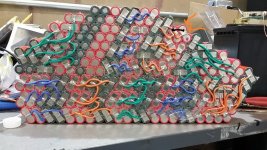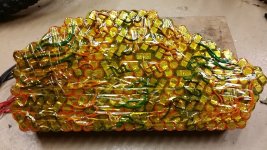I built this pack and never connected the cells in parallel. Every two cells are connected in series to another 2 cells randomly in the next parallel group.
When I check ohms between any cell in that parallel group (or the next parallel group connected with the series wires), it reads like 5-10 ohms. I'll get a negative ohms if I reverse the leads on the same cells. SO for example I'll get 6.5 ohms between two cells and if I reverse the leads I get a -4.7 ohms. I can also check voltage between any cell in the parallel group.
Not sure what is going on here. Anyone have an idea why the cells have continuity between them without having the parallel connections? Why does it read negative ohms when reversing the leads?
What also may seem very odd is I tried charging a single cell as shown in the picture with the orange arrows. It is connected only with the same tab on only the negative side as the other side the tab is connected to a different cell (basically two cells have the same nickel tab only on the negative side and on the positive the tab is connected to a different cell as shown with the black line on the other side). It was very slow charging the single cell and that is when I noticed it charging other cells in the group.
What happened was it started to charge the cells next to it (maybe others but I didn't test them all), but it also seem like other cells got discharged?????, I discharged the cell back and everything went back to the same voltages.
Thanks if anyone has an idea about what is going on here.

When I check ohms between any cell in that parallel group (or the next parallel group connected with the series wires), it reads like 5-10 ohms. I'll get a negative ohms if I reverse the leads on the same cells. SO for example I'll get 6.5 ohms between two cells and if I reverse the leads I get a -4.7 ohms. I can also check voltage between any cell in the parallel group.
Not sure what is going on here. Anyone have an idea why the cells have continuity between them without having the parallel connections? Why does it read negative ohms when reversing the leads?
What also may seem very odd is I tried charging a single cell as shown in the picture with the orange arrows. It is connected only with the same tab on only the negative side as the other side the tab is connected to a different cell (basically two cells have the same nickel tab only on the negative side and on the positive the tab is connected to a different cell as shown with the black line on the other side). It was very slow charging the single cell and that is when I noticed it charging other cells in the group.
What happened was it started to charge the cells next to it (maybe others but I didn't test them all), but it also seem like other cells got discharged?????, I discharged the cell back and everything went back to the same voltages.
Thanks if anyone has an idea about what is going on here.












